 W
WAcclimatisation societies to naturalise all kinds of new species —as long as they had no harmful effect— were established in New Zealand by European colonists from the 1860s, with the first likely having been established in Auckland around 1861.
 W
WThe Adelaide Hunt Club is an Australian fox hunting club founded in the 1840s.
 W
WThe Airedale Beagles is a beagle pack founded in 1891.
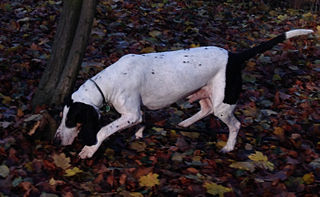 W
WThe Ariegeois is a breed of dog from the département of Ariège in the Midi-Pyrenées region of southern France. It is a medium-sized pack-hunting scenthound deriving from crossing of Grand Bleu de Gascogne and Grand Gascon-Saintongeois hounds with local Briquet dogs. It is used both as a courser and for driving game to waiting guns. While most successful with hares, it is also used for hunting deer and boar. It is distinguished by its friendly nature with other hounds and affection for human companions.
 W
WThe Buffalo Hunters' War, or the Staked Plains War, occurred in 1877. Approximately 170 Comanche warriors and their families led by Quohadi chief Black Horse or Tu-ukumah left the Indian Territory in December, 1876, for the Llano Estacado of Texas. In February, 1877, they, and their Apache allies, began attacking buffalo hunters' camps in the Red River country of the Texas Panhandle, killing or wounding several. They also stole horses from the camp of Pat Garrett.
 W
WCoursing by humans is the pursuit of game or other animals by dogs—chiefly greyhounds and other sighthounds—catching their prey by speed, running by sight, but not by scent. Coursing was a common hunting technique, practised by the nobility, the landed and wealthy, as well as by commoners with sighthounds and lurchers. In its oldest recorded form in the Western world, as described by Arrian, it was a sport practised by all levels of society, which remained the case until Carolingian period forest law appropriated hunting grounds, or commons, for the king, the nobility, and other land owners. It then became a formalised competition, specifically on hare in Britain, practised under rules, the Laws of the Leash.
 W
WThe Dundee Whaling Expedition (1892–1893) was a commercial voyage from Scotland to Antarctica.
 W
WThe European Federation for Hunting and Conservation (FACE) is a pro-hunting lobbying group based in Brussels. Established in 1977, FACE is a non-profit nongovernmental organisation. FACE is made up of national hunters’ associations from 37 European countries, including all the 27 EU member states, and is supported by 7 associate members.
 W
WFly Tyer is an American magazine dedicated to the subject of fly tying, the art of tying materials to a hook for the purposes of fly fishing. Published four times a year, Fly Tyer is currently the largest fly-tying magazine in terms of circulation. It employs "perfect binding" instead of stapled pages, and usually features a close-up image of a fly on its cover.
 W
WForest and Stream was a magazine featuring hunting, fishing, and other outdoor activities in the United States. The journal was founded in August 1873 by Charles Hallock. At the time of its 1930 cancellation it was the ninth oldest magazine still being issued in the US.
 W
WA foxhound is a type of large hunting hound bred for strong hunting instincts, a keen sense of smell, their bark, energy, drive, and speed. In fox hunting, the foxhound's namesake, packs of foxhounds track quarry, followed—usually on horseback—by the hunters, sometimes for several miles at a stretch; moreover, foxhounds also sometimes guard sheep and houses.
 W
WA game farm is a place where game animals are raised to stock wildlife areas for hunting. The term also includes places where such animals are raised to be sold as food or for photography. Their existence has been exemplified within the South African countryside where they have become prevalent. The wildlife that is hunted is used for consumption as well for ecotourism. Local laws in South Africa during the 20th century have allowed the private ownership of wildlife, which has enabled the expansion and economic feasibility of game farms over typical livestock farming.
 W
WGame Wars is a 1991 non-fiction book by Marc Reisner which gives accounts of several U.S. Fish and Wildlife Service sting operations. First published in 1991, the book centers on undercover agent Dave Hall as he infiltrates groups of poachers and gathers evidence to prosecute them. The three chapters of the book focus on poaching of alligators in Louisiana, ivory in Alaska, and sacalait in the Southern United States. The book highlights the debate over whether declines in wildlife populations should be attributed to over-hunting or loss of habitat. The book also highlights and details several cases and operations that Special Agent Hall conducted along with game wardens from the Louisiana Department of Wildlife & Fisheries – Enforcement Division.
 W
WThe German Hunting and Fishing Museum is a museum exhibiting objects connected with the history of hunting and fishing in Germany or other territories which nowadays belong to it.
 W
WGreat Prince's, Tsar's and Emperor's Hunting in Russia is a book by Russian historian Nikolai Kutepov published from 1896 to 1911.
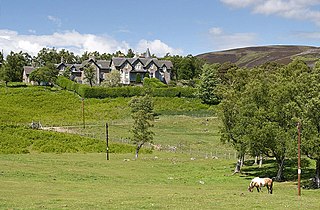 W
WInvermark Lodge is a hunting lodge which was built near Invermark Castle in 1852 for John Ramsay, 13th Earl of Dalhousie. It is now a listed building and continues to be operated as a grouse moor by the Dalhousie family.
 W
WSolveig Gunbjørg Jacobsen was the first person to be born and raised south of the Antarctic Convergence, in Grytviken, South Georgia.
 W
WJumpingpound Mountain is a mountain located 24 km (15 mi) west of Bragg Creek, Alberta in Kananaskis Country. It was named after Jumpingpound Creek in 1949 because a steep bank near the mouth was used as a buffalo jump by the Blackfoot First Nations.
 W
WGeorge McJunkin (1856–1922) was an African American cowboy, amateur archaeologist and historian in New Mexico. He discovered the Folsom Site in 1908.
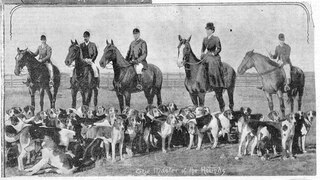 W
WThe Melbourne Hunt Club is an Australian fox hunting club founded in 1852.
 W
WThe Nantucket was a 350-ton whaler built in Nantucket, Massachusetts in 1837. First master, David N. Edwards, 1837-40, then: George Washington Gardner, 1841–45; Benjamin C. Gardner, 1845–50; Richard C. Gibbs 1850-54 ; Richard C. Gibbs (1855–59).
 W
WFrancis Allyn Olmsted was an American author.
 W
WThe Pytchley Hunt is an organisation formerly based near the Northamptonshire village of Pytchley, but since 1966 has had kennels close to Brixworth. The Pytchley country used to include areas of the Rockingham Forest but was split to form the Woodland Pytchley Hunt. Today, it covers an area of western and central Northamptonshire characterised by rolling hills, hedgerows and small areas of woodland.
 W
WThe Royal Rock Beagles was a pack of beagles founded at Rock Ferry in 1845. The pack was used to hunt hare in the Wirrall and subsequently in Wales as the character of the Cheshire countryside changed. It was for a long time the oldest beagle pack in the UK but ceased to hunt in 2015.
 W
WLeonid Pavlovich Sabaneyev was a Russian zoologist who made extensive contributions to the study of hunting in Russia.
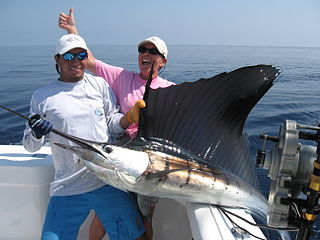 W
WSalt Water Sportsman is a monthly magazine about recreational marine fishing in the United States and throughout the world. Originally published in Boston, Massachusetts in 1939, Salt Water Sportsman expanded from its roots covering New England waters to address saltwater fishing issues throughout the world. The magazine is based in Winter Park, Florida.
 W
WFrançois Sevez was a French general during World War II. Sevez was present at the German surrender in Reims, and signed the German Instrument of Surrender as the official witness.
 W
WShooting Gazette is a monthly field sports magazine published by TI Media.
 W
WA sinkbox is a specialized hunting blind used by waterfowl hunters. It consists of a weighted, partially submerged enclosure large enough to hold one or more hunters and suspended from a floating platform. It is placed into calm water so that the hunter may wait with the waterline at approximately shoulder height.
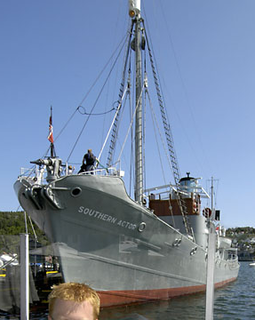 W
WSouthern Actor is a former whale catcher, currently a museum ship based in Sandefjord, Norway and owned by Sandefjord Museum. It is the only whale catcher from the Modern Whaling Epoch still to be in its original working order.
 W
WThe Warwickshire Hunt is an English fox hunting pack founded in 1791.
 W
WWhaling in Argentina was a major industry in both the South Pacific and South Atlantic coasts, and around the Falkland Islands. The primary whalers were Norwegian and Scottish ships, and the primary quarry the southern right whale.
 W
WWhaling in Seychelles was established in the early 19th century, coming largely to a close by 1915 due to declining prices for sperm whale oil, as well as the lack of materials and freight congestion due to the onset of World War I. The primary quarry, sperm whales, were generally caught near Bird and Denis Islands, and towed to a whaling station on Saint Anne.
 W
WThe practice of whaling in South Africa gained momentum at the start of the 19th century and ended in 1975. By the mid-1960s, South Africa had depleted their population of fin whales, and subsequently those of sperm and sei whales, and had to resort to hunting the small and less-profitable minke whale. Minke whales continued to be caught and brought to the Durban whaling station from 1968 until 1975. South Africa comprehensively banned whaling in 1979.
 W
WA wolf trap was a chase ending in a pit with trapdoor and stakes used by beaters in hunting wolves in medieval Europe.
 W
WThe Yushin Maru No. 3 is a Japanese-registered whale catcher that undertakes whaling operations in the North Pacific Ocean and Southern Ocean. Along with other vessels of the Japanese whaling fleet, its efforts and the ensuing conflict with the Sea Shepherd Conservation Society have been featured on American television, in the documentary-style reality series Whale Wars.